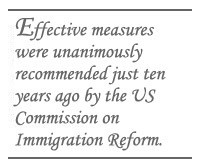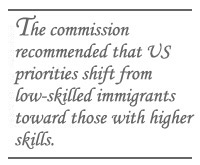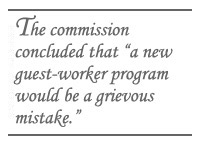As Immigration Debate Generates Heat, Dust Gathers on a Workable Plan
As Immigration Debate Generates Heat, Dust Gathers on a Workable Plan

NEW YORK: The collapse of immigration legislation in the US Senate during summer of 2007 has been described by its supporters as a failure of the center to hold. Yet the truth is that the bill was by no means centrist. Instead, it was an unstable amalgam of extreme and often mutually contradictory provisions. And contrary to the despondent conclusions by some that the US is simply incapable of restraining unlawful immigration, Congress has been sitting on workable recommendations since the 1990s.
What’s needed is courage and political will to put into effect these comprehensive set of proposals.

Just the opposite is what has happened in the Senate. A dozen senators and the White House engaged in a secretive and reportedly fractious process that stitched together a “Grand Bargain,” which they claimed would “fix a broken immigration system.” Supporters included bizarre bedfellows from otherwise antagonistic economic, ideological, regional and interest groups – all prepared to hold their noses so long as each got its own favorite provisions as part of the Grand Bargain.
That the US immigration system is “broken” is obvious. Consider that in the two decades since a previous Grand Bargain – the one that was supposed to resolve the issues permanently – some 12 million additional persons have taken up unlawful residence in the US. Like the 2007 proposals, that 1986 legislation combined legalization of millions of illegal aliens with provisions that allegedly would establish effective control over future unlawful migration. Yet only the legalization part of the 1986 Bargain was ever realized. Nearly 3 million then-unlawful residents did get legal residence, but killer amendments, inadequate funding and staff, and implementation failures by successive administrations essentially neutered the promised enforcement provisions, resulting in an estimated 12 million additional unlawful residents.
The proposed Grand Bargain of 2007 failed in the Senate. But the immigration system in place is still not working. Some say that there is nothing more that can be done.
Yet there is a set of measures already developed in considerable detail that really is “centrist” and truly bipartisan, offering the prospect of both coherence and effectiveness.

These measures were unanimously recommended just ten years ago by the US Commission on Immigration Reform. This nine-person bipartisan commission, established by Congress as part of the Immigration Act of 1990, was a “Noah’s Ark” commission – two members each appointed by the Democratic and Republican leaderships of the Senate and the House, the chair appointed by then-President Bill Clinton. For most of its seven-year life, until her untimely death in 1996, the chair was Representative Barbara Jordan (D-TX).
This commission crisscrossed the country for nearly seven years, systematically seeking local knowledge and diverse perspectives. Its members and staff took great care in examining the many details of US immigration law – second in complexity only to the US Tax Code. The Commission’s five major reports provided a comprehensive, judicious and carefully balanced set of recommendations for making US immigration policy more effective, more humane and more in the nation’s interest.
Like the Senate, the nine commission members embodied a huge range of perspectives on immigration issues. Yet unlike the Senate, they managed to reach unanimity on all recommendations.
A cynic might suppose that these unanimous recommendations were lowest-common-denominator, murky and milquetoastish. To the contrary – the recommendations were forceful and declarative.
The commission expressed its support for continuation of substantial legal immigration, but concluded that public support for such a policy was already weak and deteriorating, and would continue to decline unless illegal immigration could be effectively controlled. Substantial but well-regulated legal immigration, the commission said, is in the national interest, but illegal immigration is a threat to the nation’s long tradition of immigration and to its commitment to the rule of law.
“An effective immigration system,” the commission recommended, “requires both credible policy and sound management …. both a reliable process for verifying authorization to work and an enforcement capacity to ensure that employers adhere to all immigration related labor standards.” Effectiveness also means efficient and humane removal of those determined to be unlawfully resident.

Within the legal immigration system, the commission recommended that priorities gradually shift away from low-skilled immigrants – most of whom would be unlikely to fare well in the increasingly skills-based US labor market – and toward those with higher education and skills, and away from distant extended family members and toward immediate family members of US citizens.
The commission called for national and local measures to welcome and embrace new legal immigrants, assisting them in integrating quickly and successfully into American society. In particular, the commission advocated a renewed commitment to the education of immigrant children.
As to the now boringly-familiar demands from agricultural and other employer lobbies for hundreds of thousands of additional guest workers each year, the commission’s assessment could not have been more forceful: “... a new guest-worker program would be a grievous mistake."
The US already has a guest-worker program in place, but critics complain that it’s too small and imposes too many requirements for employers. A larger guest-worker program tempts legislators but remains controversial.

Why so? All studies of guest workers show they have been easily exploitable by employers, and that their presence depresses the wages and working conditions of US workers, especially the unskilled. In addition, large numbers of guest workers present substantial public costs for housing, health care, social services, schooling and basic infrastructure. Of course, these costs are borne by taxpayers rather than by the employers who lobby so energetically to gain access to cheap guest-worker labor. Moreover, and contrary to claims by Senate supporters, guest-worker programs have always failed to produce workers who are truly temporary, and have always failed to control further illegal migration. To the contrary, many guest workers remain permanently and often illegally.
How did the failed Senate bill compare? It did include some elements recommended by the commission. Yet it seems that no one in the Senate even tried to assess the long-term economic, social, demographic and other impacts of each of the bill’s many provisions – each included to entice and capture the votes of a few more senators.
A proposed new Grand Bargain, fatally flawed by “grievous mistakes,” died a painful death in the Senate last summer. But there is much that could now be done to deal more coherently and intelligently with the current failures of immigration policy. A good start would be for Congress to review and update the recommendations of US Commission on Immigration Reform.
Joseph Chamie is research director at the Center for Migration Studies and Michael S. Teitelbaum was vice chair of the US Commission on Immigration Reform.